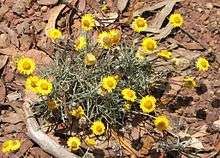Leucochrysum albicans
| Leucochrysum albicans | |
|---|---|
 | |
| Scientific classification | |
| Kingdom: | Plantae |
| (unranked): | Angiosperms |
| (unranked): | Eudicots |
| (unranked): | Asterids |
| Order: | Asterales |
| Family: | Asteraceae |
| Genus: | Leucochrysum |
| Species: | L. albicans |
| Binomial name | |
| Leucochrysum albicans (A.Cunn.) Paul G.Wilson | |
| Synonyms | |
| |
Leucochrysum albicans, commonly known as hoary sunray, is a species in the family Asteraceae. It is endemic to Australia. It grows to 45 cm high and has grey-green woolly leaves that are between 2.5 and 10 cm long and 1 to 9 mm wide. The flowerheads appear between spring and summer. These have yellow centres surrounded by either white or yellow bracts.[1]
The species was first formally described by botanist Allan Cunningham in 1825 in Geographical Memoirs on New South Wales. He gave it the name Helichrysum albicans. Subsequently the species was placed in the genus Helipterum in 1929 and Leucochrysum in 1992.[2]
The species is native to Queensland, New South Wales, Victoria and Tasmania.[1]
References
- 1 2 "Leucochrysum albicans (A.Cunn.) Paul G.Wilson". PlantNET - New South Wales Flora Online. Royal Botanic Gardens & Domain Trust, Sydney Australia. Retrieved 21 November 2011.
- ↑ "Leucochrysum albicans". Australian Plant Name Index (APNI), IBIS database. Centre for Plant Biodiversity Research, Australian Government, Canberra. Retrieved 21 November 2011.
This article is issued from
Wikipedia.
The text is licensed under Creative Commons - Attribution - Sharealike.
Additional terms may apply for the media files.